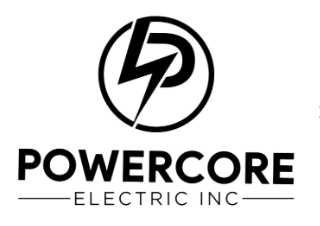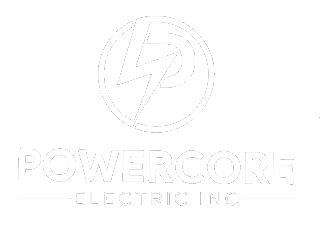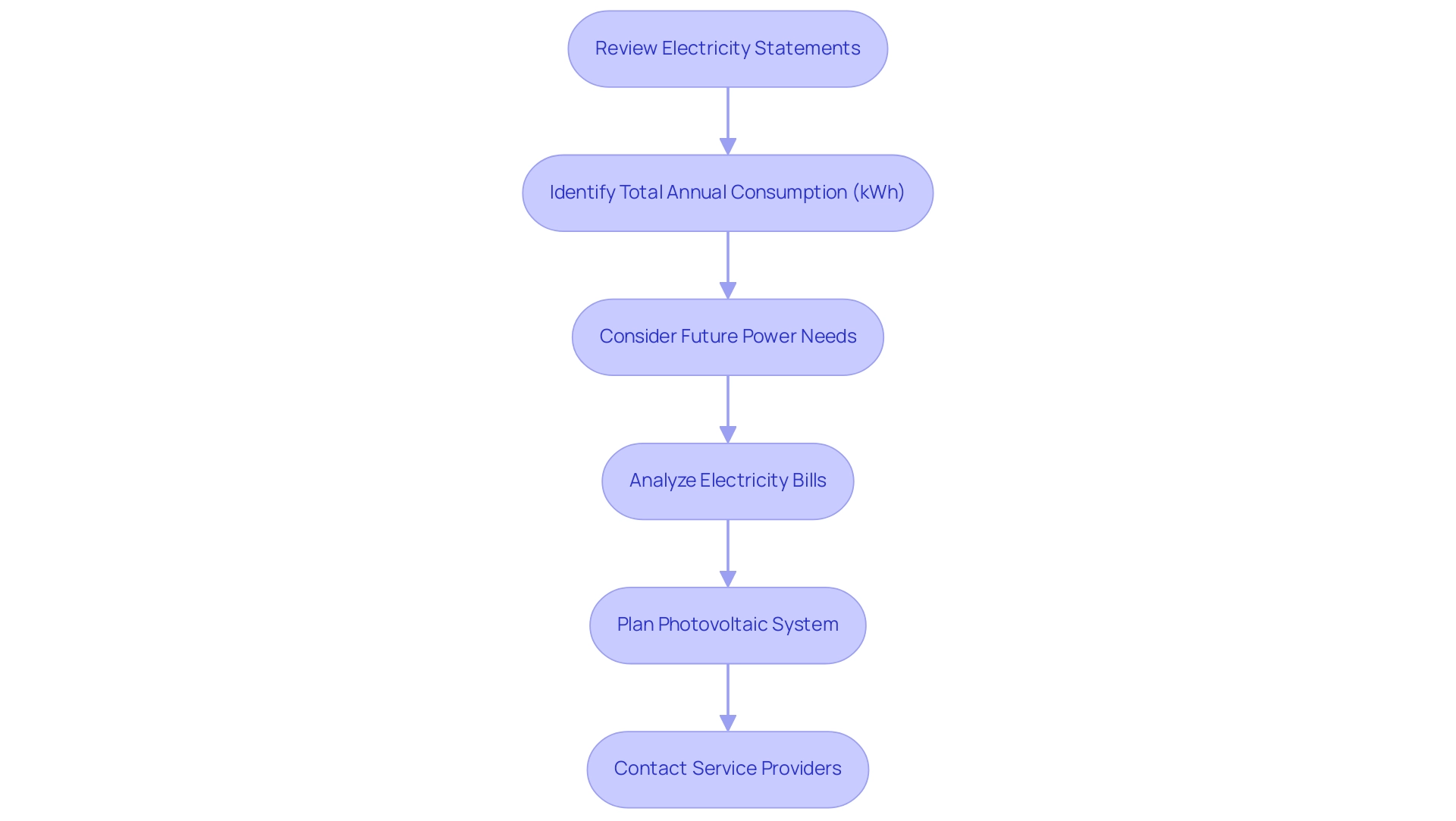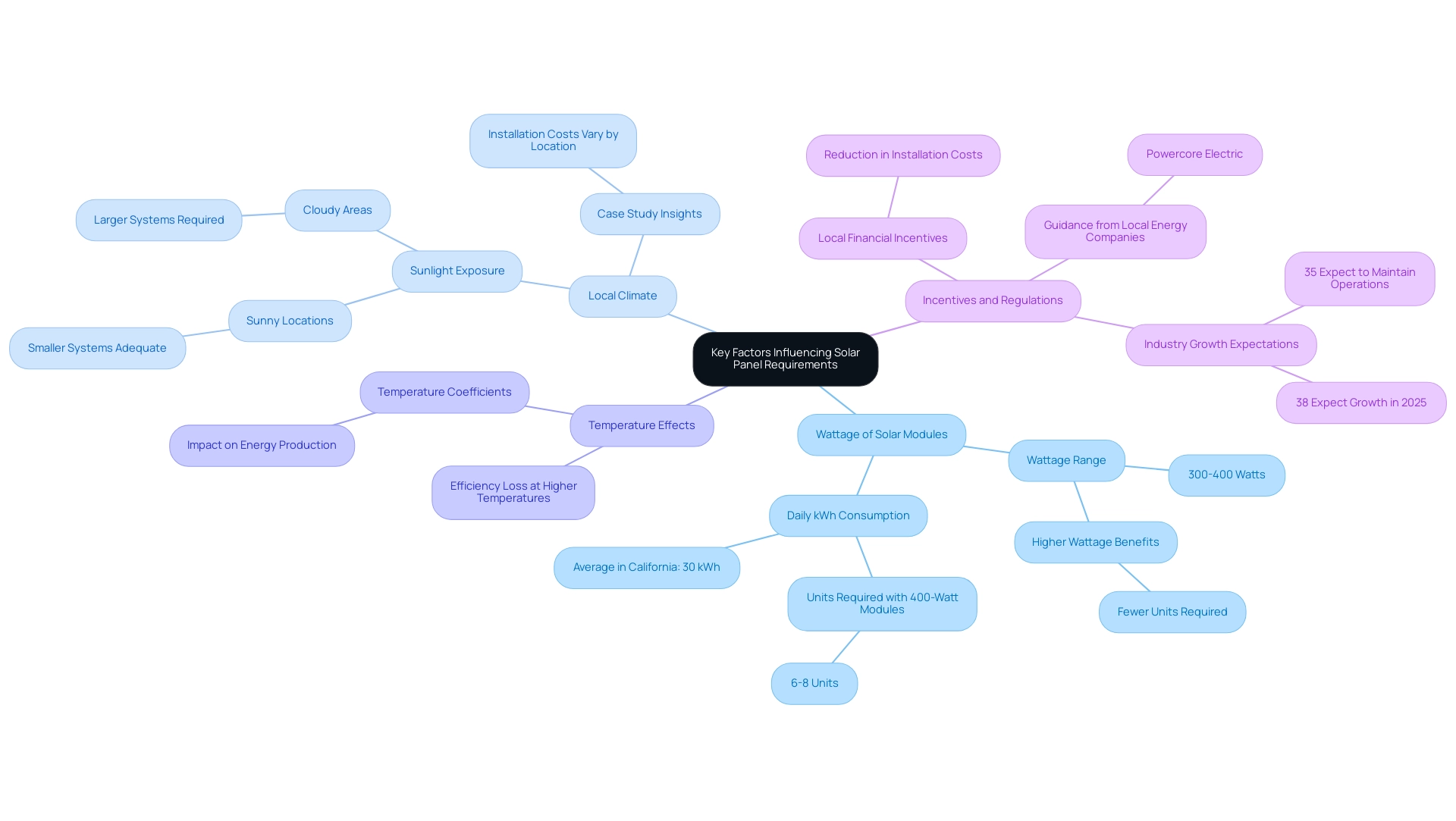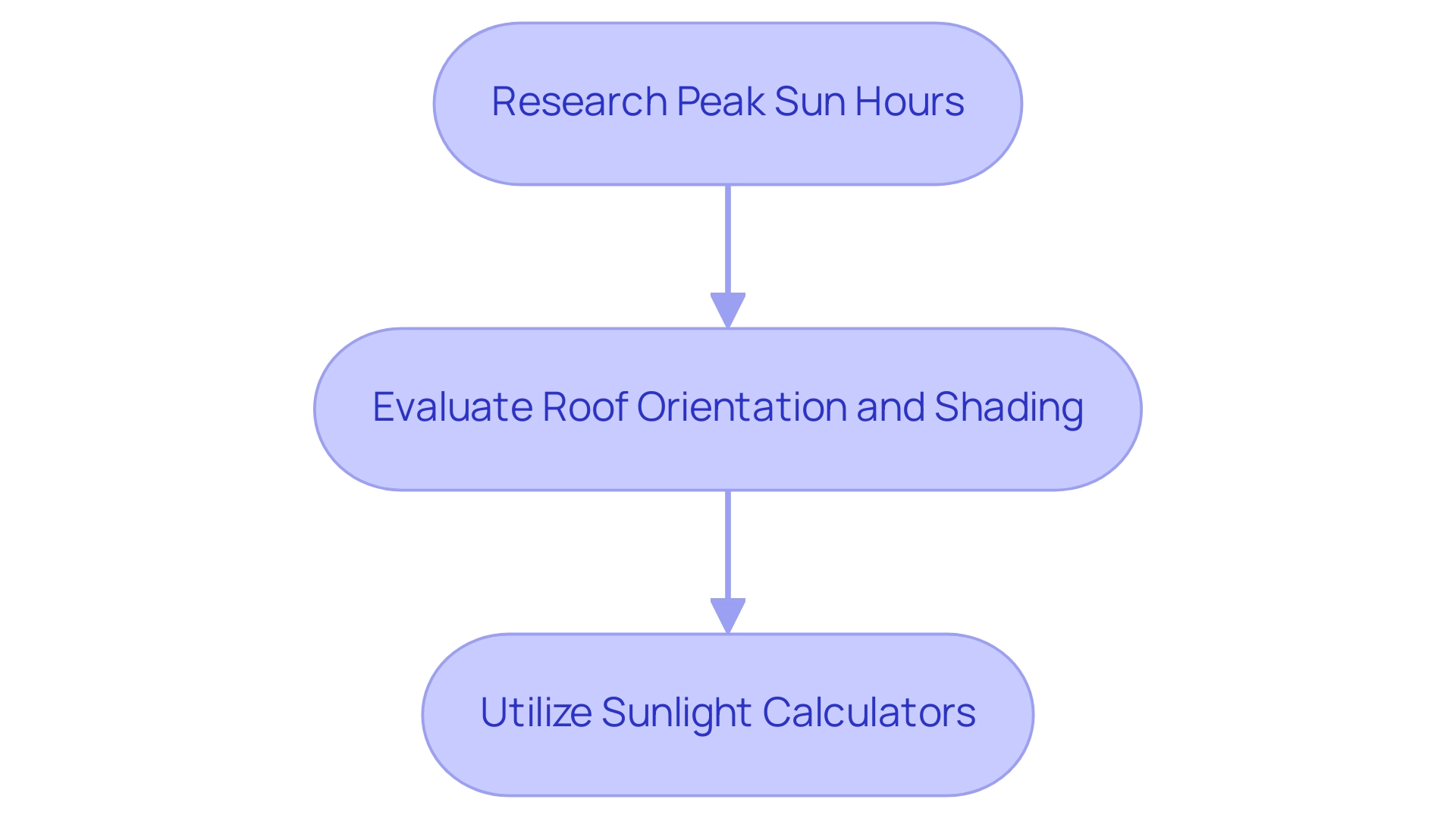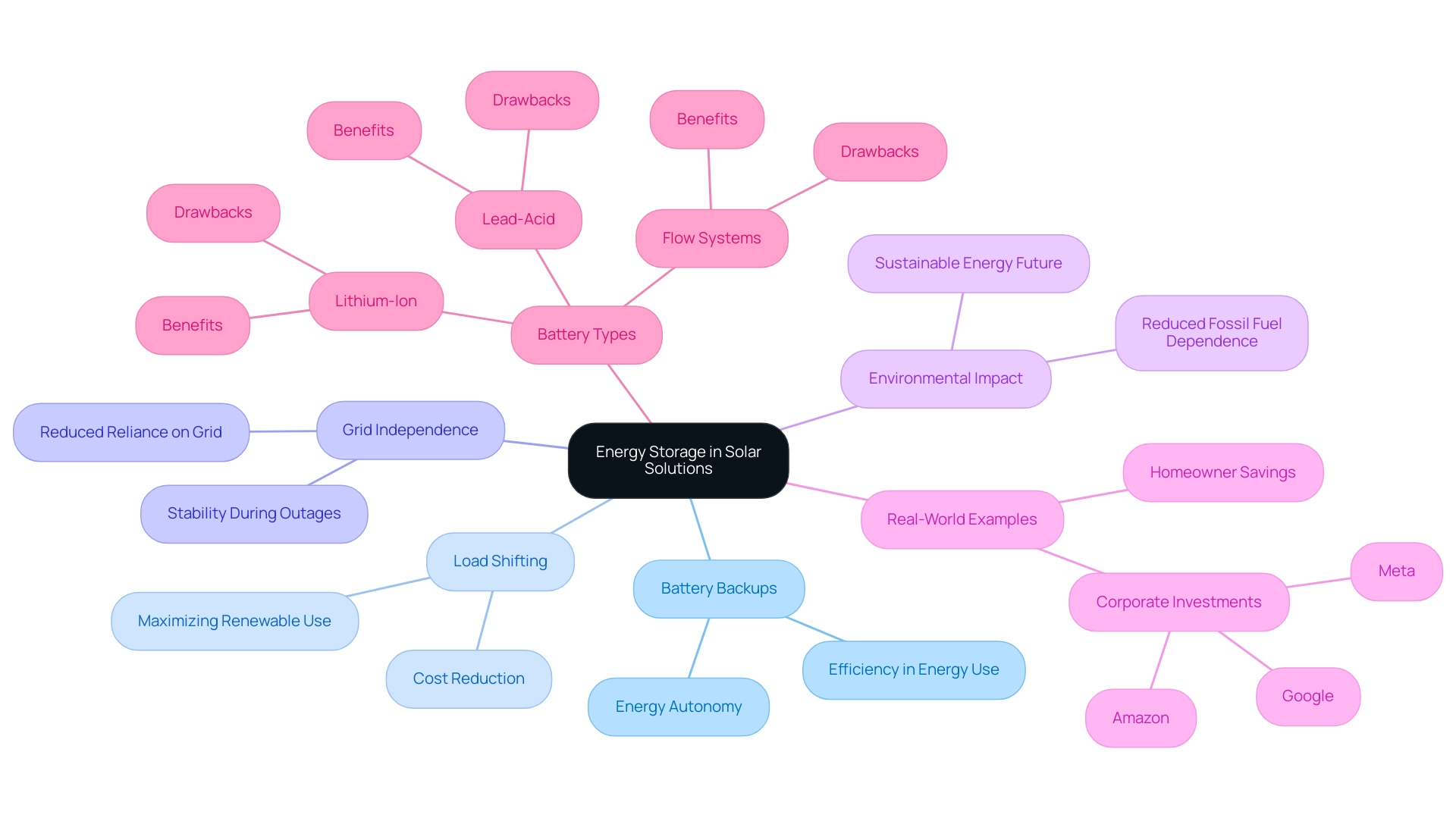Overview
We understand that navigating your energy needs can feel overwhelming, especially when considering the impact of rising electricity bills. To begin addressing these concerns, assess your annual electricity consumption in kilowatt-hours (kWh) and think about future increases that may arise from lifestyle changes, such as welcoming electric vehicles into your home. Recognizing your current and projected power usage is not just a technical necessity; it’s a step towards achieving energy independence and peace of mind.
Additionally, it’s essential to consider local sunlight conditions and the efficiencies of solar panels. Together, these factors play a crucial role in determining the optimal number of solar panels required to meet your energy demands effectively. Embracing solar energy can lead to significant savings and a more sustainable lifestyle, allowing you to contribute positively to the environment.
Let’s work towards a brighter future together. If you have questions or need guidance on this journey, please don’t hesitate to reach out. We’re here to support you every step of the way.
Introduction
In a world increasingly focused on sustainability, we understand that many homeowners, especially renters in Long Beach, are concerned about rising energy bills. The shift to solar energy presents an exciting opportunity to address these concerns while promoting energy independence and cost savings. This guide aims to support you in accurately assessing your solar energy needs, which can significantly impact your financial well-being.
Together, we can explore the essential steps to determine the right solar solutions for your home. Start by evaluating your past energy consumption and future needs, and consider the various types of solar panels available. It’s common to feel overwhelmed by the options, but by examining local sunlight potential and the role of energy storage, you can make informed decisions that align with your lifestyle and financial goals.
With expert insights and practical advice, navigating the solar landscape becomes not just manageable, but a rewarding endeavor. Let’s work towards a brighter, more sustainable future—one where you can enjoy the benefits of solar energy with confidence and support.
Understanding Your Solar Energy Needs
To effectively assess your renewable power requirements, we encourage Long Beach renters to begin by reviewing their electricity statements from the previous year. Identifying your total annual power consumption, typically expressed in kilowatt-hours (kWh), is crucial as it forms the basis for calculating your solar needs.
In California, the average household consumes approximately 6,600 kWh per year, but this can vary based on factors such as home size and usage habits. Recognizing that this is a mean can assist you in evaluating your individual circumstances more precisely.
Next, it’s important to consider your future power requirements. Anticipating potential increases in consumption due to home expansions, the addition of electric vehicles, or other lifestyle changes is essential. With the transportation sector consuming about 85% of the petroleum in California, many homeowners are transitioning to electric vehicles, which can significantly impact power usage and should be included in your calculations.
Powercore Electric provides EV charging solutions that can effortlessly connect with your renewable power system, encouraging a cleaner, more sustainable future.
Understanding your electricity bills is also essential for accurately calculating solar needs for your panels. Look for details such as peak usage times and any fluctuations in monthly consumption. This information will assist you in determining the optimal size and configuration of your energy system.
Furthermore, as residents of California encounter some of the highest electricity costs in the country, it’s vital to prepare for efficiency. While Hawaii has the highest average bill at $212.97, California’s rates are also considerable, reinforcing the urgency for renewable energy solutions. By calculating your power requirements precisely, you can effectively determine solar needs, which will not only lower your expenses but also improve your autonomy and reliability.
Additionally, we suggest reaching out to your service providers for support programs and investigating methods to decrease consumption before switching to renewable sources. This practical guidance can assist in alleviating the financial burden while preparing for a sustainable power future. Exploring alternatives such as Tesla home chargers and efficient battery systems can further enhance your power storage and utilization.
Finally, remember that a carefully planned photovoltaic system can offer long-lasting advantages, ensuring that you are ready for future power requirements while supporting sustainable practices. Powercore Electric is committed to assisting Long Beach renters throughout this process, providing tailored service and expert support to help you make informed choices about your energy solutions. Their strong community focus and commitment to transparency ensure that clients receive the best possible service throughout their energy journey.
For more information on EV charging solutions, we invite you to contact Powercore Electric today.
Key Factors Influencing Solar Panel Requirements
Several key factors influence the number of solar panels required for your home, and we understand that navigating these decisions can feel overwhelming.
- Wattage of Solar Modules: The wattage output of solar modules varies significantly, with average units in 2025 typically ranging from 300 to 400 watts. Higher wattage modules can generate more power, which may decrease the overall quantity of units required for your setup. For instance, a 400-watt panel can produce more electricity than a 300-watt panel, enabling homeowners like you to reach your usage objectives with fewer units.
Understanding your household’s power usage is crucial. In California, the average daily power consumption for households is approximately 30 kWh. By calculating your average daily kWh consumption, you can ascertain how many photovoltaic modules are necessary to satisfy your energy requirements. If you consume 30 kWh daily and use 400-watt modules, you would require around 6-8 units, depending on local sunlight conditions. Furthermore, it’s essential to verify that your electrical system is at least 200 amps to accommodate the installation.
- Local Climate: The amount of sunlight your location receives plays a significant role in determining the number of units needed. Areas with ample sunlight will require fewer units to produce the same quantity of power compared to regions with reduced light exposure. For example, a homeowner in a sunny location may discover that a smaller system is adequate, whereas an individual in a cloudier area, like Stockton, may require a larger setup to attain comparable production. Investigating local sunlight exposure levels can offer insight into how much energy you can anticipate from your modules. A case study on location and solar installation costs indicates that solar installation costs vary by location due to differences in sunlight exposure, electricity needs, and available incentives.
- Temperature Effects: Solar collector efficiency can be affected by temperature, with higher temperatures leading to production losses. Understanding the temperature coefficients of your chosen panels is essential to calculate solar needs and anticipate how much energy they will produce under varying conditions. This knowledge is crucial for understanding the overall performance of photovoltaic systems.
- Incentives and Regulations: Local incentives and regulations can also influence the size and type of energy system you choose. Certain regions, such as Stockton, provide financial incentives that can reduce installation expenses. It’s crucial to take these factors into account when planning your energy project. Local energy companies, such as Powercore Electric, can provide guidance on available incentives and assist you in navigating the installation process. As Ben Zientara, a renewable energy policy analyst, observes, “38% of all firms in the solar sector anticipate growth in 2025, and another 35% believe they will sustain their current level of operations,” suggesting an optimistic perspective for the photovoltaic industry that may advantage property owners.
By considering these factors, you can make knowledgeable choices about your photovoltaic requirements. Together, we can ensure that you utilize clean power effectively and sustainably while also acknowledging the financial and ecological advantages of renewable heating systems. Let’s work towards a brighter, more sustainable future for your home.
Assessing Sunlight Potential in Your Area
To effectively assess the sunlight potential for solar energy in your area, we invite you to follow these essential steps, keeping in mind your concerns about energy bills and the desire for sustainable solutions:
- Research Peak Sun Hours: Begin by determining the average peak sun hours specific to your location. In California, for instance, peak sun hours can vary significantly, with averages ranging from approximately 2.73 hours in December to about 6.77 hours in July. This information is crucial as it helps you calculate your solar needs, directly affecting the effectiveness and production of your energy converters. We understand that navigating these details can feel overwhelming, but as energy journalist Zeeshan Hyder observes, “Understanding your local conditions is key to maximizing the benefits of renewable energy.”
- Evaluate Roof Orientation and Shading: Conduct a thoughtful inspection of your roof to identify any potential obstructions that could cast shadows on your energy panels. Common culprits include trees, chimneys, and nearby buildings. Generally, south-facing roofs are ideal for energy installations, as they receive the most sunlight throughout the day. It’s common to feel uncertain about how shading affects your energy production; even small obstructions can lead to significant decreases in power generation. According to the case study titled “Factors Affecting Peak Sun Hours for Solar Modules,” various elements such as orientation and local weather patterns can significantly influence power generation. This emphasizes the importance of calculating your solar needs for careful planning in module installation.
- Utilize Sunlight Calculators: Leverage online tools such as the PVWatts Calculator to estimate the output of photovoltaic panels based on your specific location and roof characteristics. These calculators take into account factors such as peak sun hours, roof angle, and shading, offering a more precise estimate of potential power generation.
By following these steps, you can make informed choices about your renewable power requirements, ensuring that your investment in photovoltaic technology is both efficient and effective. Together, we can navigate the path to energy independence. For more detailed guidance on photovoltaic functionality and the best battery selections for efficient energy storage, please refer to the user manuals provided by Powercore Electric.
Exploring Different Types of Solar Panels
When considering solar modules for your home, we understand that navigating the various types and their efficiencies can feel overwhelming. It’s essential to make an informed choice that aligns with your needs and aspirations for energy independence.
Monocrystalline Modules: These are renowned for their high efficiency, typically between 20-21%. Crafted from single-crystal silicon, their sleek design and exceptional performance make them an excellent option for homeowners with limited roof space. They require less area to generate the same amount of power compared to less efficient alternatives. JA Solar offers high-efficiency monocrystalline modules that are recognized for their durability and power generation, making them suitable for utility-scale projects. Many homeowners are choosing these modules to enhance energy production in confined rooftop areas, as highlighted by case studies that showcase the impact of module efficiency on solar system design.
Polycrystalline Panels: Constructed from multiple silicon crystals, these panels are generally more affordable but offer slightly lower efficiency than their monocrystalline counterparts. They present a viable option for property owners seeking budget-friendly solutions without sacrificing too much performance. This makes them a popular choice among budget-conscious homeowners in Stockton, California, who are exploring local solar companies.
Thin-Film Modules: Lightweight and flexible, these structures are versatile and can be installed in various settings. However, they typically exhibit lower efficiency rates, making them suitable for specific applications where weight and flexibility are critical considerations.
Bifacial Modules: Designed to absorb sunlight from both sides, bifacial modules can significantly enhance power generation, especially in environments with reflective surfaces. This innovative design allows for increased output, making them an appealing choice for maximizing energy production.
As we look towards 2025, monocrystalline modules continue to lead the market due to their efficiency and performance, while polycrystalline modules remain a favorite among budget-conscious homeowners. As Tom Beresnyak notes, a skilled installer can make a significant difference; the angle and mount are crucial for maximizing what you have at your location. Ultimately, when calculating your solar needs, it’s vital to consider both efficiency and the specific power requirements of your home.
It’s also essential to remember that photovoltaic systems are evaluated under regulated conditions, and real-world circumstances may result in lower output than efficiency ratings suggest. Investing in a high-efficiency solar solution not only contributes to a healthier planet but also leads to considerable cost savings, enhancing your power independence and promoting sustainability. Together, we can explore the best options for your home and ensure you make a choice that supports your energy goals.
Calculating Solar Panel Needs for Your Home Size
To accurately determine the number of solar panels required for your home, let’s take a moment to consider your energy needs and how we can work together to achieve energy independence.
- Understanding Your Daily Power Requirements: Begin by calculating your annual power consumption in kilowatt-hours (kWh). By dividing this figure by 365, you can find your average daily consumption. For instance, if your household uses 10,000 kWh each year, your daily power requirements would be approximately 27.4 kWh. In 2023, California’s total power consumption was 6,882 trillion Btu, which underscores the importance of understanding individual power needs within the broader context of state consumption patterns.
- Calculating Required Solar Output: Next, let’s assess the average peak sun hours in your area. In California, homeowners can expect around 5 to 6 peak sun hours per day. By dividing your daily power requirements by the average peak sun hours, you can determine the necessary output in kilowatts (kW). Using our previous example, if your daily energy needs are 27.4 kWh and you receive 5 peak sun hours, your required output would be about 5.48 kW (27.4 kWh / 5 hours).
- Selecting Your Solar Wattage: Choose the wattage of the solar units you intend to install. Common options include 300W or 400W modules. The wattage will affect how many modules you require to satisfy your power needs.
- Determining the Quantity of Modules: Finally, divide the necessary energy output by the wattage of your chosen units. For instance, if your required output is 5.48 kW and you choose 300W panels, you would need around 19 panels (5480W / 300W = 18.27, rounded up to 19).
By following these steps, you can effectively calculate your solar needs to determine the number of panels necessary to fulfill your household’s power requirements. This process not only helps in organizing your photovoltaic system but also aligns with California’s commitment to renewable resources. As the state continues to excel in power efficiency and sustainable practices, it’s heartening to know that the California Energy Commission is funding renewable resource development, further supporting residents in their transition to photovoltaic power.
Understanding your daily energy requirements and output calculations from photovoltaic systems is essential for homeowners looking to optimize the benefits of these installations. Together, we can make informed decisions that contribute to a sustainable future.
Financial Considerations: Costs and Savings of Solar Panels
When considering solar panels, we understand that evaluating financial aspects is essential for making an informed decision. Here are some key points to consider:
- Installation Costs: The average expense for a residential panel system in California ranges from $13,549 to $25,974, influenced by factors such as system size and geographical location. This investment can lead to significant long-term savings, especially in a state known for its high electricity costs.
- Incentives and Tax Credits: It’s important to explore available federal and state incentives that can substantially lower installation expenses. The Federal Solar Tax Credit, for example, allows property owners to subtract a significant portion of their installation expenses from their federal taxes, enhancing the availability of renewable power.
- Long-Term Savings: Evaluating potential savings on electricity bills is crucial. Many homeowners can anticipate saving between $31,000 and $100,000 over the lifespan of their energy systems, depending on local electricity rates and individual usage patterns. This substantial financial benefit highlights the appeal of renewable energy in California, where the average energy system pays for itself in about seven years.
- Return on Investment (ROI): Assessing the payback period for your solar investment is vital. Typically, homeowners can expect to break even on their investment within 8 to 12 years. This timeframe can vary based on factors such as energy consumption and the efficiency of the installed system.
- Financing Options: Considering financing options is also important. For instance, the average monthly payment for a 7.2 kW energy system using a typical loan is approximately $130.31. This information can assist you in planning for your energy investment.
- Comparing Quotes: It’s advisable to compare multiple quotes for energy systems, as doing so can lead to savings of up to 20% on panel costs. As Jeni R., a verified customer, noted, “EnergySage saved me a ton of money by helping me get bids that were half the cost of the bids I got myself by calling around. I can’t say enough good about this organization. Don’t invest in renewable energy without it!”
- Real-World Examples: The case study titled “Affordability and Benefits of Utilizing Solar Power in California” highlights that California is one of the best places to adopt renewable resources due to low power requirements, abundant sunlight, and high electricity expenses. Homeowners can anticipate significant savings and a rapid return on investment, making renewable power an appealing choice in California.
By understanding these financial factors, you can calculate your solar needs to manage the installation process more effectively and optimize your investment in sustainable power solutions. At Powercore Electric, with over 30 years of experience in California, we are dedicated to outstanding service and community assistance. Together, we can ensure tailored service and support for you, further enhancing your installation experience.
The Role of Energy Storage in Solar Solutions
Power storage solutions are essential for optimizing the benefits of harnessing sunlight, especially as we look towards 2025. We understand that concerns about energy bills can weigh heavily on homeowners. Here’s how these solutions can make a meaningful difference:
- Battery Backups: These systems capture and store surplus power generated during the day, ensuring that you have energy available for use at night or during outages. This capability empowers you to calculate your solar needs, enhancing your energy autonomy and allowing for more efficient use of renewable resources.
- Load Shifting: By strategically storing energy, you can utilize solar power during peak hours when electricity costs soar. This practice not only helps reduce overall expenses but also maximizes the use of renewable resources.
- Grid Independence: With power storage, you can lessen your reliance on the grid. This shift provides a buffer against rising electricity costs and potential outages, ensuring a more stable power supply for your home.
- Environmental Impact: Using stored sunlight significantly reduces reliance on fossil fuels, contributing to a more sustainable energy future.
In fact, global investment in battery energy storage surpassed USD 20 billion in 2022, and projections suggest it will exceed USD 35 billion in 2023, reflecting a growing commitment to renewable energy solutions. When considering your solar needs, key factors include battery capacity, efficiency, lifespan, price, and ecological benefits. Powercore Electric offers a range of solar batteries that showcase these features, helping environmentally conscious homeowners choose the best options for their needs.
Real-World Examples: Many homeowners in California are already enjoying the advantages of battery backups. For example, those who have installed storage systems report significant savings on their bills and greater resilience during power outages. This trend is underscored by the installation of nearly 40 GW of photovoltaic capacity and over 1.8 GWh of battery storage by major corporations by Q1 2024, demonstrating a robust commitment to renewable energy.
Case Studies: Companies like Meta, Amazon, and Google exemplify the effectiveness of power storage in maximizing sunlight benefits. Their diverse sourcing strategies reflect a strong dedication to renewable resources, serving as an inspiring example for homeowners eager to enhance their photovoltaic systems. Furthermore, the alleviation of supply chain issues and increased U.S. production have made solar panels more accessible, aiding property owners considering renewable power options.
Examining photovoltaic batteries, including Lead-Acid, Lithium-Ion, and Flow Systems, reveals distinct benefits and drawbacks that you should evaluate based on your unique energy requirements.
In conclusion, energy storage systems not only improve the efficiency of renewable energy but also empower homeowners to manage their energy consumption, reduce costs, and support a sustainable future. Together, we can work towards a brighter, more energy-independent tomorrow.
Choosing Local Solar Providers for Personalized Service
When selecting a solar provider, we understand that homeowners often have concerns about rising energy bills and the search for sustainable solutions. Choosing local companies like Powercore Electric can provide numerous advantages that cater specifically to your needs:
- Personalized Service: Local providers excel in delivering tailored solutions that cater specifically to the unique needs of residents within the community. Powercore Electric’s commitment to customer satisfaction ensures that installations are optimized for individual circumstances, enhancing overall satisfaction.
- Familiarity with Local Regulations: Local companies possess in-depth knowledge of state and local regulations, which facilitates compliance and streamlines the installation process. Powercore Electric’s expertise minimizes potential delays and ensures that all installations meet necessary standards.
- Community Support: Choosing a local provider not only benefits you as a property owner but also contributes to the local economy. By supporting Powercore Electric, you help sustain jobs and foster economic growth within your community, creating a positive feedback loop that benefits everyone.
- Reputation and Trust: Local companies often thrive on word-of-mouth referrals and a strong community reputation. Powercore Electric’s reliance on local trust leads to higher accountability and customer satisfaction, as they are motivated to maintain their standing within the community. As one satisfied customer noted, “Ryan and his team at Powercore Electric were great. They were quick, effective, and remained on schedule for our energy installation. I have referred Powercore to some friends, and they were also happy with their service.”
- Customer Satisfaction Statistics: Recent surveys indicate that 78% of renewable energy installers anticipate increased sales in 2025, reflecting a growing confidence in local providers like Powercore Electric. This trend underscores the importance of customer satisfaction and the effectiveness of personalized service in driving business success.
- Case Studies on Economic Impact: A recent report highlighted that rooftop energy installations saved California electricity customers an estimated $1.5 billion in 2024. This finding illustrates the broader economic benefits of decentralized energy solutions, reinforcing the value of local energy providers in contributing to both individual savings and community wealth.
- Financial Considerations: The average expense of photovoltaic installations in California is around $20,000 before incentives. Understanding this financial aspect is crucial for you as a property owner as you calculate solar needs while evaluating your options.
- Market Insights: While some of the cheapest energy companies in California focus on leases and Power Purchase Agreements (PPAs), local providers like Powercore Electric often offer more personalized service and tailored solutions that can lead to better long-term satisfaction.
- Customer Testimonials: As Bob B., a verified customer, stated, “EnergySage saved me a ton of money by helping me get bids that were half the cost of the bids I got myself by calling around. I can’t say enough good about this organization. Don’t invest in renewable energy without it!” This emphasizes the significance of selecting a provider that can assist residents through the process effectively.
By selecting local energy providers like Powercore Electric, you not only gain access to personalized service and expertise but also play a vital role in supporting your community and enhancing your energy independence. With over 30 years of experience, Powercore Electric is committed to exceptional service, offering a range of solutions including solar panels, battery backups, and EV charging stations. Together, we can work towards a sustainable future that benefits both you and your community.
Conclusion
Understanding your solar energy needs is essential for homeowners who wish to lower their energy costs and embrace a more sustainable lifestyle. We recognize that assessing past electricity consumption, anticipating future needs, and exploring the different types of solar panels available can feel overwhelming. However, by taking these steps, renters in Long Beach can make informed decisions about their solar solutions. Remember, the local sunlight potential and energy storage are vital factors that directly impact the performance and efficiency of your solar system.
Financial considerations also play a crucial role in your solar journey. It’s important to be aware of installation costs, available incentives, and the long-term savings that solar systems can offer. A thoughtfully planned solar investment can lead to significant financial benefits, making the transition to renewable energy solutions more accessible. With local providers like Powercore Electric, you’ll find personalized service and expert guidance, which can make navigating the solar landscape a rewarding experience.
In conclusion, embracing solar energy goes beyond merely reducing your bills; it’s about making a meaningful contribution to a sustainable future. By investing in solar solutions, homeowners not only gain financial advantages but also take important steps toward energy independence and environmental stewardship. Together, with the right knowledge and support, transitioning to solar energy can be a transformative journey, paving the way for a brighter and more sustainable lifestyle. Let’s work towards this goal together.
